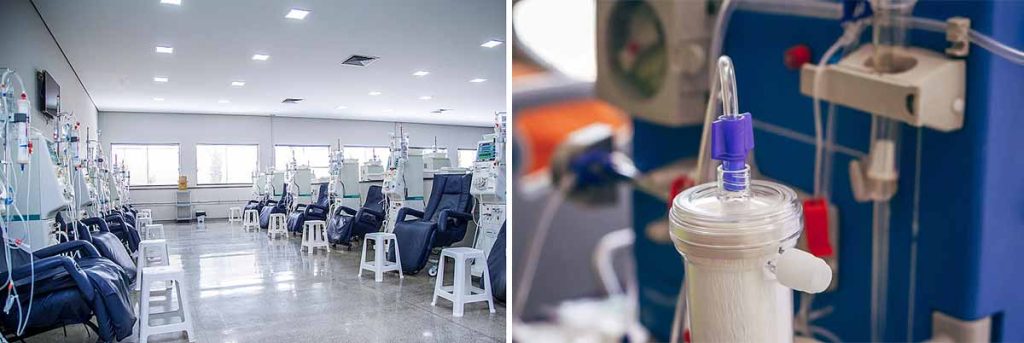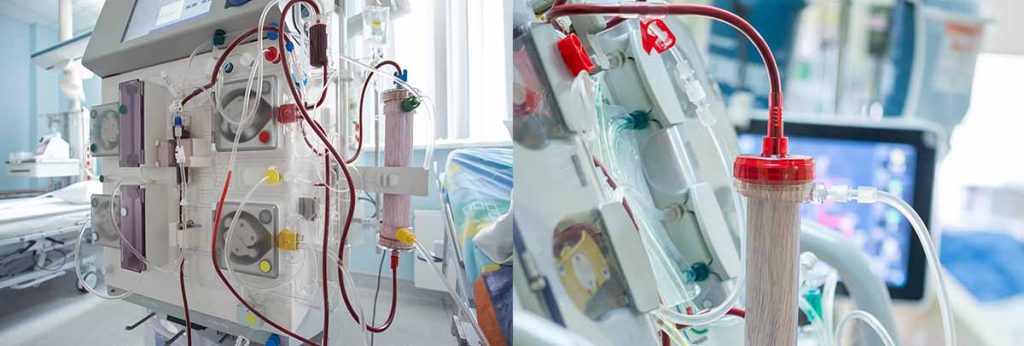

Dialysis and hemoglobin are crucial for patients with kidney disease. The dialysis significantly affects red blood cell production by influencing erythropoietin activity and iron availability. Research indicates that dialysis patients often experience a shortened lifespan of red blood cells, which can lead to tissue hypoxia. This condition prompts the body to increase erythropoietin production and draw on iron reserves. Furthermore, studies reveal that hemoglobin levels in patients receiving hemodialysis typically range from 10.0 to 12.0 g/dL, while those on peritoneal dialysis tend to have slightly lower levels. These variations emphasize the necessity of monitoring anemia in dialysis patients to enhance their overall health outcomes.
Key Takeaways
- Dialysis changes hemoglobin levels and can cause anemia. Checking often helps manage this problem.
- Erythropoietin helps make red blood cells. People with kidney problems often don’t have enough, leading to low hemoglobin.
- Many dialysis patients don’t have enough iron. Taking iron pills or getting iron through IV can help hemoglobin levels.
- Keeping hemoglobin between 10–12 g/dL is safer. This range helps the body get oxygen and stay healthy.
- Working with doctors helps control anemia better. Regular visits and special care plans help dialysis patients feel healthier.
Dialysis and Hemoglobin: The Physiological Connection
The Role of Erythropoietin in Red Blood Cell Production
Erythropoietin plays a vital role in maintaining healthy hemoglobin levels. This hormone, produced by the kidneys, stimulates the bone marrow to create red blood cells. In patients with chronic kidney disease, the kidneys lose their ability to produce sufficient erythropoietin. As a result, red blood cell production declines, leading to anemia. Dialysis cannot restore this hormonal function, making erythropoietin deficiency a common issue. Without adequate red blood cells, oxygen delivery to tissues decreases, causing fatigue and other symptoms. Addressing this deficiency is essential for improving the quality of life in dialysis patients.
Iron Deficiency Anemia in Dialysis Patients
Iron deficiency anemia is a frequent complication for individuals undergoing dialysis. This condition arises when the body lacks enough iron to produce hemoglobin. Studies show that functional iron deficiency affects 22% of hemodialysis patients, while absolute iron deficiency impacts 24%. These deficiencies are more prevalent in dialysis patients due to factors like poor dietary intake, reduced iron absorption, and blood loss during treatments. Additionally, 50% of hemodialysis patients experience normochromic anemia, which further highlights the widespread nature of this issue. Monitoring iron levels and addressing deficiencies through supplementation or intravenous therapy can help manage anemia effectively.
Blood Loss During Dialysis and Its Impact on Hemoglobin
Blood loss during dialysis contributes significantly to anemia. Hemodialysis treatments often involve minor but consistent blood loss, which can accumulate over time. This occurs due to blood remaining in the dialysis tubing and filters after each session. Frequent blood sampling for laboratory tests also adds to the loss. For patients already struggling with low hemoglobin levels, this can exacerbate anemia. Maintaining optimal iron levels and using erythropoiesis-stimulating agents can help counteract the effects of blood loss. Regular monitoring ensures that interventions are tailored to each patient’s needs, minimizing the impact on their overall health.
The Importance of Hemoglobin Levels in Dialysis Patients
Anemia and Its Health Risks
Anemia poses significant health risks for individuals undergoing dialysis. Low hemoglobin levels reduce the oxygen-carrying capacity of red blood cells, leading to tissue hypoxia. This condition often results in fatigue, dizziness, and reduced physical performance. In patients with chronic kidney disease, anemia is particularly concerning as it exacerbates existing health issues. Studies suggest that maintaining hemoglobin levels within the optimal range of 10–12 g/dL minimizes these risks. A hemoglobin level below 10 g/dL increases the likelihood of complications, including hospitalization and mortality. Addressing anemia in chronic kidney disease is essential to improve patient outcomes and overall well-being.
| Evidence Description | Findings |
|---|---|
| Optimal Hb range for dialysis patients | The study supports an optimal Hb range of 10–12 g/dL. |
| Mortality risk associated with hemoglobin levels | The lowest mortality risk was found in the Hb range of 11–12 g/dL. |
| Establishing a lower limit for hemoglobin levels | A lower limit of 10 g/dL is considered reasonable. |
Cardiovascular Risks of Abnormal Hemoglobin Levels

Abnormal hemoglobin levels in dialysis patients significantly impact cardiovascular health. Low hemoglobin levels increase the workload on the heart, leading to left ventricular hypertrophy and heart failure. Conversely, excessively high hemoglobin levels may raise the risk of thrombosis. Research highlights that proactive treatment targeting a hemoglobin level of 11 g/dL reduces cardiovascular risks. Additionally, maintaining hemoglobin levels above 10.5 g/dL for longer periods decreases the risk of cardiovascular events by approximately 8%. However, high variability in hemoglobin levels is linked to a 10% increase in cardiovascular death rates. Consistent monitoring and management of hemoglobin levels are crucial for reducing these risks.
| Finding | Description |
|---|---|
| Target Hemoglobin Level | Proactive treatment targeting a hemoglobin level of 11 g/dL reduced cardiovascular risk. |
| Effect Size | The risk of cardiovascular events decreased by approximately 8% as the mean length of hemoglobin level above 10.5 g/dL increased by 1 month. |
| Hemoglobin Variability | High hemoglobin variability was significantly associated with increased risk of cardiovascular disease (CVD). |
| Statistical Measure | A 1 standard deviation increase in hemoglobin variability was linked to a 10% increase in cardiovascular death rate. |
The Impact on Energy and Quality of Life
Hemoglobin levels directly influence energy levels and quality of life in dialysis patients. Low hemoglobin levels often result in chronic fatigue, making it difficult for patients to perform daily activities. This fatigue can lead to emotional distress and a diminished sense of independence. On the other hand, maintaining hemoglobin levels within the recommended range improves oxygen delivery to tissues, enhancing physical stamina and mental clarity. Patients with stable hemoglobin levels report better overall health and fewer hospitalizations. Addressing anemia through proper management strategies can significantly improve the quality of life for individuals with kidney disease.
Anemia Management During Dialysis
Erythropoiesis-Stimulating Agents (ESAs)
Erythropoiesis-stimulating agents (ESAs) play a critical role in anemia management for dialysis patients. These medications stimulate the bone marrow to produce red blood cells, addressing the low hemoglobin levels caused by reduced erythropoietin production in chronic kidney disease. However, achieving target hemoglobin levels with ESAs can be challenging. Clinical trials reveal that many patients fail to reach predefined hemoglobin targets, complicating the evaluation of treatment outcomes. Full anemia correction using ESAs may also increase the risk of adverse events, including cardiovascular complications and mortality. Therefore, healthcare providers often aim for moderate hemoglobin levels to balance the benefits and risks. Regular monitoring ensures that ESA therapy is tailored to individual needs, improving anemia management and quality of life.
Iron Supplements and Intravenous Iron Therapy
Iron supplementation is essential for managing iron deficiency anemia in dialysis patients. Oral iron supplements are often insufficient due to poor absorption and dietary restrictions. Intravenous (IV) iron therapy provides a more effective alternative, especially for hemodialysis patients. Studies confirm that IV iron therapy maintains stable hemoglobin levels and reduces the need for higher ESA doses. For example, monthly maintenance doses of 100–200 mg effectively sustain ferritin and transferrin saturation levels. However, IV iron therapy carries potential risks, such as oxidative stress and cardiovascular complications. Despite these concerns, safety data shows that the incidence of adverse events, including vascular thrombosis, remains similar across different dosing regimens. Careful monitoring of iron levels helps optimize therapy while minimizing risks.
| Evidence Type | Findings |
|---|---|
| Safety Events | Similar incidence of vascular thrombosis and hospitalization across groups. |
| Effectiveness | 200 mg/month reduced ESA doses but had a higher iron withholding rate (64.1%). |
| Maintenance Dosing | 100–200 mg/month maintained hemoglobin and ferritin levels effectively. |
Dietary Strategies for Iron Deficiency Anemia
Dietary strategies complement medical treatments for iron deficiency anemia in dialysis patients. Iron-rich foods, such as lean meats, beans, and fortified cereals, support hemoglobin production. However, dialysis patients often face dietary restrictions that limit iron intake. Nutritional studies emphasize the importance of tailoring dietary plans to individual needs. Regular monitoring of ferritin and transferrin saturation levels helps guide dietary adjustments. Adequate iron intake also enhances the effectiveness of ESA therapy, making it a vital component of anemia management. Collaboration with dietitians ensures that patients receive balanced nutrition while addressing the challenges of kidney disease.
| Evidence Point | Description |
|---|---|
| Role of Iron in Anemia Management | Iron supports hemoglobin production, especially for patients on ESA therapy. |
| Importance of Iron Supplementation | Iron supplementation is crucial, with oral or IV options based on patient needs. |
| Monitoring Iron Status | Regular monitoring helps tailor dietary and treatment strategies effectively. |
| Integration with ESA Therapy | Adequate iron levels improve ESA effectiveness, enhancing anemia management. |
Regular Monitoring and Individualized Care
Regular monitoring and individualized care are essential components of anemia management for dialysis patients. Monitoring hemoglobin levels allows healthcare providers to identify trends and make timely adjustments to treatment plans. Individualized care ensures that interventions address each patient’s unique needs, improving outcomes and quality of life.
Frequent assessments of hemoglobin levels help maintain them within the target range of 10–13 g/dL. Over a 12-month period, the percentage of patients achieving this range increased from 60% to 80%. This improvement highlights the effectiveness of consistent monitoring and tailored care strategies. Adjustments to erythropoietin doses and iron supplementation contributed to these results, demonstrating the importance of optimizing iron status in anemia management.
Clinical practice guidelines, such as KDOQI and EBPG, provide a framework for enhancing care quality in hemodialysis patients. These guidelines emphasize the importance of regular monitoring and individualized care in addressing anemia in chronic kidney disease. By following these recommendations, healthcare providers can reduce complications associated with low hemoglobin levels and improve patient outcomes.
Individualized care involves tailoring anemia management strategies to each patient’s condition. For example, patients with iron deficiency may benefit from intravenous iron therapy, while others may require adjustments to erythropoiesis-stimulating agents. Dietary strategies also play a role in maintaining iron levels, supporting hemoglobin production. Collaboration between patients and healthcare teams ensures that care plans align with individual needs, enhancing the effectiveness of anemia management.
Tip: Patients should actively participate in their care by attending regular check-ups and discussing symptoms with their healthcare providers. This collaboration fosters better communication and ensures timely interventions.
Regular monitoring and personalized care not only stabilize hemoglobin levels but also reduce hospitalizations and improve energy levels. These strategies empower patients to manage anemia effectively, enhancing their overall health and quality of life.

Conclusion
Dialysis profoundly affects hemoglobin levels, influencing anemia and overall health. Effective anemia management improves outcomes for dialysis patients by reducing mortality and enhancing quality of life. Research shows that 45% of hemodialysis patients maintain hemoglobin levels between 11.0 and 12.0 g/dL, while 30% fall between 10.0 and 11.0 g/dL. However, 10% have levels below 10.0 g/dL, increasing health risks. Consistent monitoring and individualized care help stabilize hemoglobin levels, minimizing fluctuations that can worsen comorbidities.
| Evidence Description | Findings |
|---|---|
| Anemia management impact on HD patients | Good anemia management lowered mortality and morbidity, improving HRQOL. |
| Hemoglobin level variability | 38.4% of patients had Hb levels between 11 and 12 g/dL consistently. |
| Fluctuation in Hb levels | Patients experienced a +/-1.4-g/dL fluctuation in Hb levels annually. |
Collaboration between patients and healthcare providers is essential for maintaining optimal hemoglobin levels. Regular monitoring, dietary adjustments, and medications ensure better management of anemia, empowering patients to lead healthier lives.
